湖南黄金洞金矿床白钨矿Sm-Nd年龄及其地质意义
周岳强, 董国军, 许德如, 邓 腾, 吴 俊, 王 翔, 高 磊, 陈孝刚
湖南黄金洞金矿床白钨矿Sm-Nd年龄及其地质意义
周岳强1,2,3, 董国军3*, 许德如1,4, 邓 腾4, 吴 俊3, 王 翔3, 高 磊5, 陈孝刚5
(1. 中国科学院 广州地球化学研究所 矿物学与成矿学重点实验室, 广东 广州 510640; 2. 中国科学院大学, 北京 100049; 3. 湖南省 地质矿产勘查开发局 四〇二队, 湖南 长沙 410004; 4. 东华理工大学 核资源与环境国家重点实验室, 江西 南昌 330013; 5. 湖南黄金洞矿业有限责任公司, 湖南 岳阳 414507)
黄金洞金矿床是江南造山带上重要的金矿产地之一, 矿体赋存在新元古代的浅变质岩中, 受东西向-北西西向构造的严格控制。多年来, 黄金洞金矿床的成矿年龄一直存在着争议。通过对黄金洞金矿区的白钨矿开展详细的野外调查、岩相学观察和Sm-Nd同位素分析, 在147Sm/144Nd-143Nd/144Nd图解中获得白钨矿的等时线年龄为(129.7±7.4) Ma (MSWD=1.0), 对应的Nd()值为−8.21~ −8.68。结合黄金洞矿区白钨矿与含金硫化物的交切关系观察、以及前人的成矿年代学和矿物学研究成果, 认为白钨矿的等时线年龄可作为黄金洞金矿床的成矿年龄。白钨矿的Nd() 值大于赋矿地层新元古界冷家溪群和湘东北早白垩世花岗岩, 但小于新元古界仓溪岩群, 表明白钨矿中的Nd部分来自新元古界冷家溪群和(或)湘东北早白垩世花岗岩, 部分来自新元古界仓溪岩群。综合前人的研究, 认为在江南造山带的金锑钨成矿作用中, 新元古界为矿源层, 区域变质作用和岩浆作用共同促进了金等成矿物质的活化, 构造活化为含矿热液的运移和沉淀提供了通道和空间。
金矿床; 白钨矿; Sm-Nd同位素; 湘东北; 江南造山带
0 引 言
在对金矿床定年时, 最理想的方式是选取与金同期的矿物进行直接定年[1]。然而, 热液型金矿床中往往缺少可通过传统方法直接定年的矿物。因此, 其成矿年龄的确定成为一个难以解决的问题[1–2]。近几十年来, 人们发现很多金矿床中都有白钨矿的出现, 且这些白钨矿与金关系密切, 常被作为重要的找矿标志[3–6]。又由于白钨矿中的Ca2+与Sm、Nd等稀土元素有着相似的半径和电子结构[7], 使得白钨矿具有较高的稀土元素含量和Sm/Nd比值[1,8]。因此, 自20世纪80年代 Fryer.[3]首次成功实现Sm-Nd同位素定年以来, 白钨矿Sm-Nd同位素定年逐渐被运用于许多金矿床的研究中[1,9–12]。
江南造山带是华南著名的金锑钨铜铅锌多金属成矿带, 带内分布着数百个金-(锑)-(钨)矿床(点)。多年来, 前人针对江南造山带上的金-(锑)-(钨)矿床的成矿时代进行了大量研究, 但得到的年龄大多为流体包裹体Rb-Sr等时线年龄[13–25]、黄铁矿和方铅矿等的Pb-Pb模式年龄[26–27]、石英裂变径迹年龄[28]等类型。流体包裹体Rb-Sr等时线年龄极易受到次生流体包裹体的影响; Pb-Pb模式年龄则容易因为后期热液活动导致Pb的丢失而不准确; 由于石英的U含量低且不均匀, 石英裂变径迹年龄的准确性也不高, 且所测的石英也可能为非成矿期的石英。因此, 这些年龄相互之间差异很大, 在很大程度上已制约着对江南造山带金锑钨成矿机理的深入研究。自2003年彭建堂等[11]通过白钨矿的Sm-Nd同位素测试获得沃溪金锑钨矿床的成矿年龄开始, 一些学者[12,29–34]以白钨矿、含金毒砂以及辉锑矿等与金锑钨矿床的成矿阶段密切相关的矿物为对象, 运用Sm-Nd同位素、Re-Os同位素等可靠程度较高的测年方式, 获得了江南造山带西南段沃溪金锑钨矿床、渣滓溪钨锑矿床、板溪锑矿床、字溪金矿床、金井金矿床、龙山锑金矿床、平秋金矿床和八克金矿床的成矿年龄。
黄金洞金矿床位于江南造山带中段的湘东北地区, 是江南造山带上最重要的几个金矿床之一。前人曾获得黄金洞金矿床的黄铁矿Pb-Pb模式年龄为552~416 Ma[26], 流体包裹体Rb-Sr等时线年龄为(425±33) Ma[23]和(152±13) Ma[20]。由于这些测年方法存在着较大的局限性, 黄金洞金矿床目前仍缺乏可靠程度高的成矿年龄。在黄金洞金矿床的勘探开采过程中我们发现, 矿区金品位较高的地段往往有白钨矿出现。基于此, 本次研究拟对黄金洞金矿区的含白钨矿矿石进行详细的野外和镜下观察, 并对白钨矿进行Sm-Nd同位素测试, 以获得黄金洞金矿床的成矿年龄并探讨白钨矿中Nd的来源。在此基础上, 结合前人的研究成果, 探讨江南造山带上金- (锑)-(钨)矿床的成因。
1 区域地质
江南造山带位于扬子陆块与华夏陆块的接合部位、扬子陆块的东南缘, 又被称为“江南古陆”“江南古岛弧”“江南隆起”[35–36](图1), 以大面积出露元古宇(1.85~0.8 Ga)浅变质火山碎屑岩为特征[20]。此外, 古生代和中生代的浅海相和陆相地层也有少量出露。中生代的陆相沉积多分布于一系列断陷盆地之中[36,40]。
江南造山带的构造演化与新元古代以来扬子陆块与华夏陆块的活动紧密相关[41]。新元古代, 作为Rodinia大陆聚合的重要组成部分, 扬子陆块与华夏陆块发生碰撞, 形成了江南造山带[42]。之后, 江南造山带在加里东期、印支期和燕山期经历了多期的构造作用。早古生代, 南华裂谷盆地闭合, 扬子和华夏陆块之间再次发生碰撞, 拉开了加里东期陆内造山作用的序幕。这次造山作用在江南造山带前泥盆纪地层中形成了一系列北西‒近东西向的韧性剪切带、断裂和褶皱构造[43–44], 形成了大量的花岗岩、花岗闪长岩和少量的火山岩[45], 并使得地层普遍发生绿片岩相‒角闪岩相的变质[41]。印支期的造山作用发生于早中生代, 它使得华南最终成为Pangea超大陆的一部分[46]。同时, 它使得华南早三叠世以前的地层大量褶皱变形和形成逆冲推覆构造, 并伴随着区域变质作用和岩浆活动[47–48]。印支期岩浆岩规模较小, 以S型花岗岩为主。燕山期, 随着古太平洋板块向欧亚板块的俯冲和回撤, 江南造山带发育了一系列北东向的深大断裂和断陷盆地[49], 同时形成了大量的花岗岩、基性‒超基性岩脉和基性‒酸性火山岩[50–52]。

图1 湘东北地质及大地构造位置图
(a) 华南构造划分图(据文献[37]修改); (b) 湘东北地区构造地质图(据文献[38,39]修改)。
1–第四系; 2–白垩纪‒第三纪砂岩和砾岩; 3–中泥盆世‒中三叠世碳酸盐岩、砂岩和泥岩; 4–震旦纪‒志留纪砂岩、页岩、砾岩和板岩; 5–新元古界板溪群碎屑沉积岩; 6–新元古界冷家溪群浅变质浊积岩; 7–新元古界仓溪岩群片岩, 片麻岩; 8–燕山期花岗岩; 9–印支期花岗岩; 10–加里东期花岗岩; 11–元古宙花岗岩; 12–断裂; 13–韧性剪切带; 14–金矿床(点); 15–钴矿点; 16–锡矿化; 17–钨矿化; 18–铍矿化; 19–铌钽矿化; 20–铜矿化; 21–铅锌矿化; 22–钨锡矿化; 23–铜多金属矿床(点)。
(a) Tectonic framework of South China (modified after reference [37]); (b) geological and structural map of northeastern Hunan (modified after references [38,39]).
1–Quaternary; 2–Tertiary-Cretaceous sandstone and conglomerate; 3–Middle Triassic-Middle Devonian carbonate, sandstone and siltstone; 4–Silurian-Sinian sandstone, shale, conglomerate and slate; 5–clastic sediments of the Neoproterozoic Banxi Group; 6–low-grade metamorphosed turbidites of the Neoproterozoic Lengjiaxi Group; 7–schist and gneiss of the Neoproterozoic Lengjiaxi Group; 8–Yanshanian granitoids; 9–Indosinian granitoids; 10–Caledonian granitoids; 11–Proterozoic granit0ids; 12–fault; 13–ductile shear zone; 14–Au deposit or occurrence; 15–Co deposit; 16–Sn mineralization; 17–W mineralization; 18–Be mineralization; 19–Ni-Ta mineralization; 20–Cu mineralization; 21–Pb-Zn mineralization; 22–W-Sn mineralization; 23–Cu polymetallic deposit or occurrence
湘东北地区位于江南造山带的中段(图1a)。区内出露的地层主要为新元古界、中生界白垩系及新生界第四系。新元古界主要分布于断隆带上, 由仓溪岩群、冷家溪群和板溪群组成。仓溪岩群主要由云母片岩和黑云母斜长片麻岩组成。冷家溪群和板溪群为一套具有复理石建造的浅变质火山碎屑岩和黏土岩。冷家溪群主要由板岩、(粉)砂质板岩和变质杂砂岩组成, 由老至新依次为雷神庙组、黄浒洞组、小木坪组和大药姑组。冷家溪群与上覆板溪群呈角度不整合接触[53]。新元古界的冷家溪群和板溪群富含Au、Sb和W等元素[54], 是金锑钨矿床的主要赋矿地层[36]。其中, 冷家溪群含Au 0.5~44.2 ng/g, 是地壳克拉克值的1~8倍[38]; 含钨5~15 μg/g, 局部高达0.18%[54]。白垩系和第四系主要分布于断陷盆地。除此以外, 震旦纪至三叠纪的地层在区内也有少量出露(图1b)。
湘东北地区北东向深大断裂发育。以这些断裂为界, 湘东北被划分为一系列相间分布的断隆和断陷盆地, 被称为“盆‒岭式构造”[41]。此外, 2004年肖拥军等[55]根据构造形迹和地球物理资料认为, 湘东北地区还存在着三条近东西向的韧性剪切带。新元古代、加里东期、印支期和燕山期岩浆岩在湘东北地区都有出露[56]。新元古代岩浆岩包括长三背、葛藤岭、大围山和张邦源等岩体, 主要为S型花岗岩, 成岩年龄大多分布于833~816 Ma之间, 形成于同碰撞的构造环境[35,57–61]。加里东期岩体包括张坊、板杉铺和宏夏桥等, 成岩年龄为434~432 Ma,为I型花岗岩, 为加厚的中下地壳发生部分熔融而成[62–63]。印支期岩浆岩仅在湘东北的西南部有出露, 成岩年龄分布于250~233 Ma之间, 目前相关研究较少[64]。燕山期岩浆岩出露面积最大, 主要为S型花岗岩, 是伸展环境下加厚下地壳发生部分熔融的产物[65], 代表性岩体有连云山岩体、望湘岩体及金井岩体(图1b)。其中, 连云山岩体主要由中细粒二云母花岗岩和中粗粒斑状黑云母花岗岩组成, 为强过铝质S型花岗岩[39], 其成岩年龄分布于 155~130 Ma之间[49,56],常见绿泥石化、绿帘石化、高岭土化及绢云母化。在连云山岩体周围, 由近到远依次出现W-Sn-Nb- Ta-Be矿化带、Cu-Pb-Zn矿化带和Au矿化带(图1b)[38,39]。
湘东北地区是江南造山带重要的金矿产地之一。区内产出有大万(大洞和万古)、黄金洞和雁林寺等多个金矿床(点), 它们均分布于北东向深大断裂长平断裂带两侧新元古代冷家溪群的板岩之中(图1b)。其中, 大万和黄金洞金矿床均为大型‒超大型金矿床。
2 矿床地质
黄金洞金矿床位于湘东北地区北东向长沙‒平江深大断裂带(简称长平断裂带)的SE侧(图1b)。区内出露的地层主要为新元古界冷家溪群大药姑组, 局部被第四系覆盖。大药姑组主要由粉砂质板岩、砂质板岩和绢云母板岩组成。岩石普遍经受了区域浅变质作用, 产生的蚀变主要为绢云母化, 其次为弱硅化及少量绿泥石化、黄铁矿化和碳酸盐化。矿区内褶皱和断裂都很发育。褶皱主要为倒转背向斜, 褶皱枢纽呈北西(西)走向。区内发育两组断裂, 分别为东西向‒北西西向和北东向。东西向‒北西西向断裂的走向与褶皱枢纽方向大致平行。北东向断裂主要为泥湾断裂和许多近平行的次级断裂。这些断裂走向北北东, 倾向北西西, 倾角通常大于50°。矿区内尚未发现有火成岩出露(图2)。
截至2018年, 黄金洞金矿区已探明的金资源量(保有资源量+已开采资源量)达82 t, 平均品位约5 g/t[66]。矿区共发现19条金矿脉, 走向东西向至北西西向, 受东西向‒北西西向断裂控制。其中, 1号脉和3号脉的金资源量占整个矿区金资源量的50%以上。1号脉倾向北, 倾角20°~40°, 沿走向延伸长约3200 m, 矿体厚0.46~2.16 m。3号脉倾向南, 倾角45°~70°, 沿走向延伸长约3300 m, 矿体厚约0.74~ 3.65 m。矿石类型主要为石英脉型和蚀变岩型, 少量为构造角砾岩型(图3a~3c)。矿石矿物主要为毒砂和黄铁矿, 少量为白钨矿、辉锑矿、方铅矿、闪锌矿、黄铜矿和自然金等。脉石矿物主要为石英和方解石, 少量为绿泥石、绢云母和白云石等。金呈自然金、晶格金和纳米级金颗粒三种形式存在。其中, 晶格金和纳米级金颗粒主要赋存于毒砂和含砷黄铁矿中[56,67,68]。近矿围岩的蚀变类型多样, 主要蚀变类型为硅化、黄铁矿化和毒砂化, 可见少量的绢云母化和绿泥石化。局部围岩可见辉锑矿化和叶腊石化。
根据野外和镜下观察到的穿插关系, 可将黄金洞金矿床的热液作用划分为四个阶段(图4): 第一阶段以无矿石英(Qz1)为特征, 石英颗粒较大(图3c); 第二阶段以白钨矿和石英(Qz2)为特征(图3e); 第三阶段为金多金属硫化物阶段, 形成石英(Qz3)、毒砂、黄铁矿、方铅矿和自然金矿物组合(图3f); 第四阶段由方解石、石英(Qz4)和少量黄铁矿组成(图3g~3h)。其中, 第三阶段与金成矿有关。局部可观察到第二阶段的白钨矿细脉切穿了第一阶段形成的无矿石英(Qz1) (图3c~3e), 同时又被第三阶段形成的金多金属硫化物细脉切穿(图3c、3e和3f)。
3 样品采集及分析测试方法
本次研究的含白钨矿矿石均采自3号矿脉(图2), 详细采样位置见表1。矿区的白钨矿通常为乳白色, 油脂光泽, 呈细脉状、团块状产出。
在详细进行野外和室内观察的基础上, 首先将样品碎至粒径约0.25 mm (60目)。然后, 在双目镜下借助荧光灯挑选白钨矿。在挑选过程中, 将混晶和杂质剔除, 使白钨矿的纯度达到99%以上。最后, 将挑选出来的白钨矿碎至粒径约0.075 mm (200目)。白钨矿Sm-Nd同位素的测定工作在中国地质调查局武汉地质调查中心的Triton热电离质谱仪上完成。详细的操作流程参考李华芹[69]。样品分析测试在超净化实验室完成。通过同位素稀释法得到Sm和Nd含量, 直接对提纯的样品分析得到Nd同位素比值, 质谱分析过程中产生的质量分馏采用146Nd/144Nd=0.7219进行幂定律校正。在分析过程中,采用GBW04419、BCR-2和GSW标准物质对全流程和仪器进行监控。GBW04419的测定结果为Sm=3.028 μg/g, Nd=10.08 μg/g,143Nd/144Nd= 0.512720±0.000005(1σ), 与其证书值(3.03±0.04、10.10±0.12、0.512725±0.000005(2σ))在误差范围内一致; BCR-2的测定结果为Sm=6.54 μg/g, Nd=28.85 μg/g,143Nd/144Nd=0.512636±0.000008 (1σ), 与其推荐值(6.41~6.73、27.62~28.97、0.512618~0.512650)在误差范围内一致; GSW的测定结果为143Nd/144Nd = 0.512433±0.000005(1σ), 与推荐值0.512438±6(2σ)在误差范围内完全一致。标准全流程Sm、Nd空白分别为3.0×10−11g和2.0×10−11g, 对样品分析结果的影响可忽略不计。Sm和Nd含量的分析误差优于1%,147Sm/144Nd的分析误差为0.005%。Sm-Nd同位素年龄通过Isoplot程序分析处理[70]。计算时采用的147Sm衰变常数为6.54×10−12a−1, 球粒陨石均一储库(CHUR)现代的147Sm/144Nd和143Nd/144Nd值分别采用0.1967和0.512638[71]。
李达是中共一大的发起者、筹备者、召集者和组织者,他和夫人王会悟也是同时参加党的一大的唯一一对夫妻。在中国共产党早期领导人中,“还很少有像李达同志这样勤奋、这样有丰富的卓越的成就,这样在任何困难危险的环境下生命不息、战斗不止的马克思主义宣传家、教育家,这样坚定勇敢而不断追求进步,力求达到当代的最高水平的马克思主义理论战士”。他为中国共产党的创立,为马克思主义在中国的传播,为丰富毛泽东哲学思想作出了重要贡献。
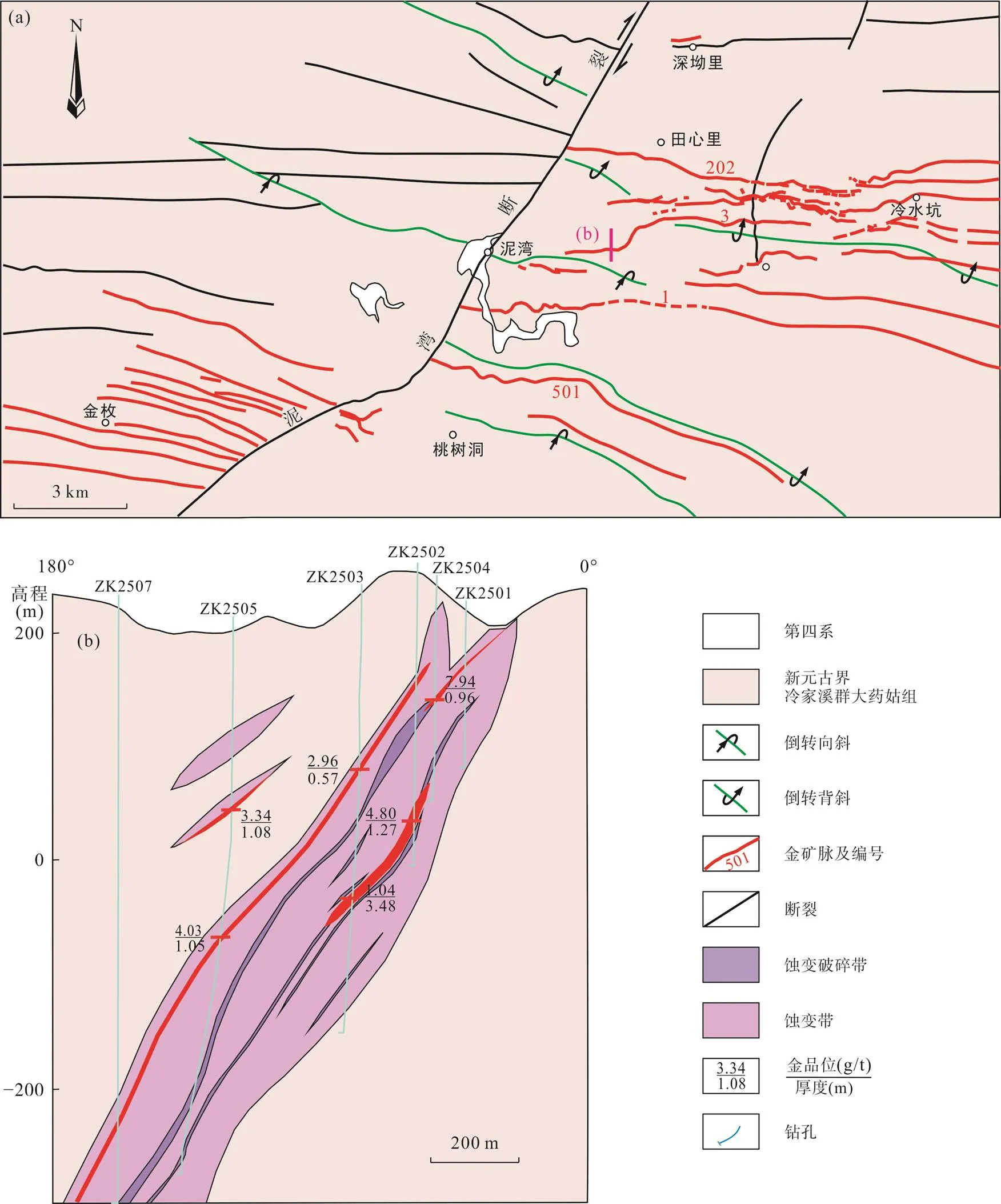
图2 黄金洞矿区地质图(据文献[36]修改)
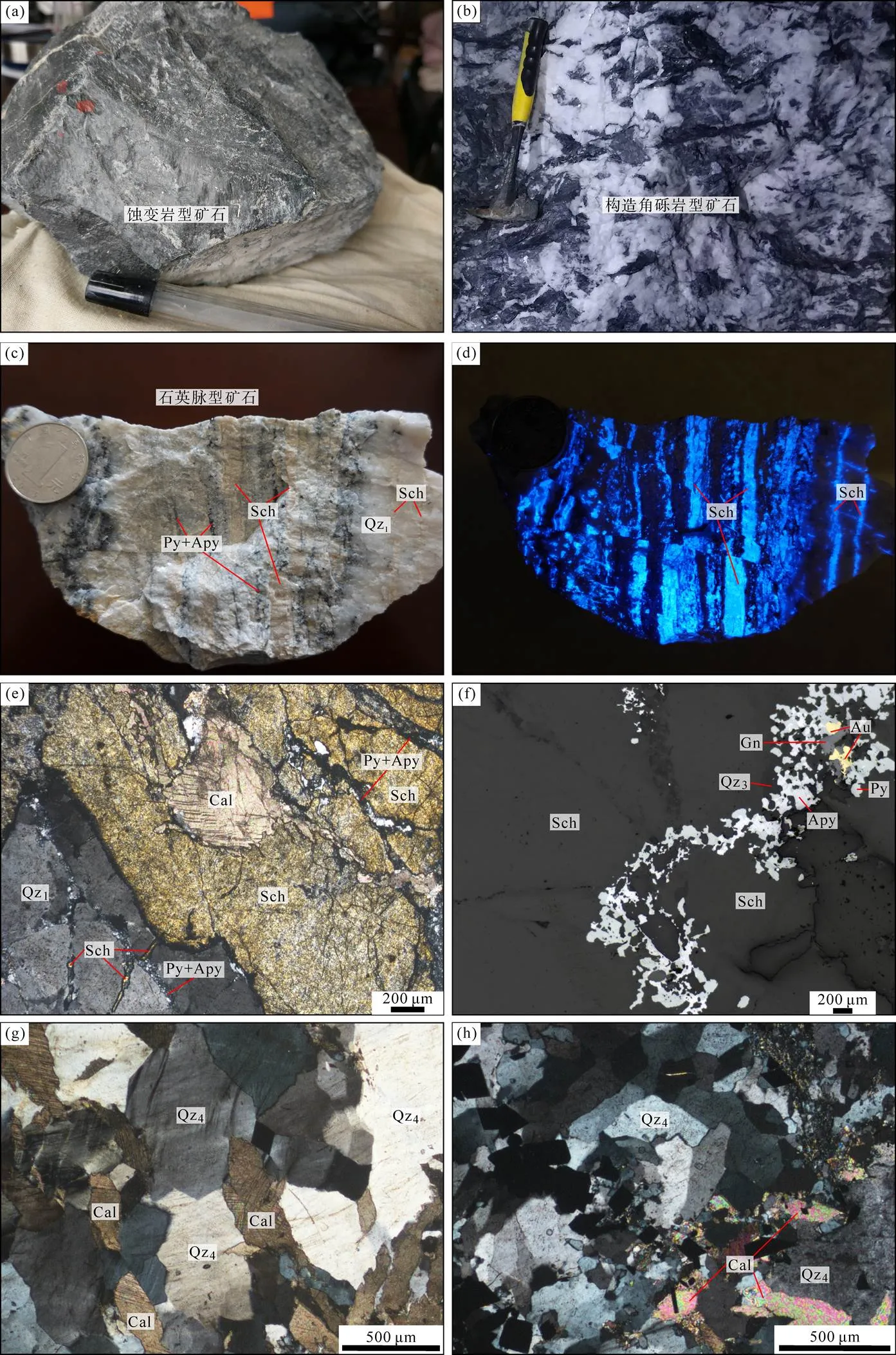
图3 黄金洞矿区矿脉野外、手标本及显微镜下照片
(a) 蚀变岩型矿石; (b) 构造角砾岩型矿石; (c) 石英脉型矿石手标本; (d) 紫外荧光灯照射下的石英脉型矿石手标本; (e) 白钨矿细脉切穿了无矿石英, 又被黄铁矿、毒砂细脉切穿(正交偏光); (f) 金多金属硫化物细脉切穿白钨矿(反射光); (g) 和 (h) 石英和方解石的矿物组合(正交偏光)。Apy–毒砂; Au–自然金; Cal–方解石; Gn–方铅矿; Py–黄铁矿; Qz–石英; Sch–白钨矿。
(a) Altered rock type ore; (b) tectonic breccia type ore; (c) quartz vein type ore; (d) quartz vein type ore irradiated by the ultraviolet fluorescent lamp; (e) vein of scheelite crosscutting barren quartz and crosscutted by vein of pyrite and arsenopyrite (cross-polarized light); (f) vein of Au polymetallic sulfide crosscutting vein of scheelite (reflected-light); (g) and (h) quartz and calcite (cross-polarized light). Apy–arsenopyrite; Au–native gold; Cal–calcite; Gn–galena; Py–pyrite; Qz–quartz; Sch–scheelite
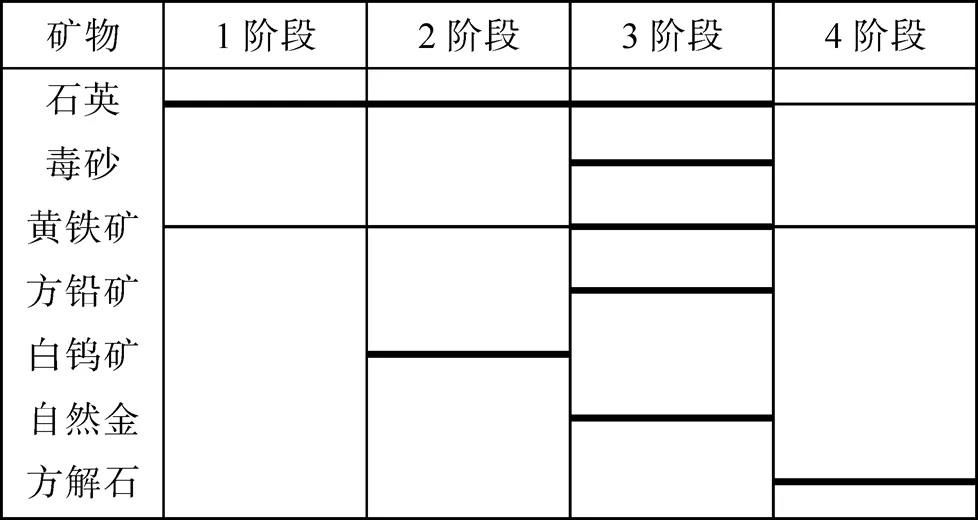
图4 黄金洞金矿床的成矿阶段和矿物组合
4 分析测试结果
黄金洞矿区3号脉采集的5件样品中白钨矿的Sm和Nd含量以及同位素组成如表1所示。白钨矿Sm和Nd的含量分别为0.5517~5.1330 μg/g和0.5854~ 3.5100 μg/g,147Sm/144Nd比值分布于0.5702~1.1130之间,143Nd/144Nd比值分布于0.512521~0.512979之间。在143Nd/144Nd-147Sm/144Nd图解中, 5个白钨矿样品表现出良好的线性关系(图5)。运用Isoplot程序求得白钨矿的等时线年龄(129.7±7.4) Ma, MSWD为1.0, (143Nd/144Nd)i值为0.512040±0.000038 (图5), 对应的Nd()值为−8.21 ~ −8.68 (表1)。由于所有样品均采自黄金洞矿区3号矿脉, 是同源同期热液活动的产物, 本次获得的年龄(129.7±7.4) Ma可代表白钨矿的真实形成年龄。
5 讨 论
5.1 黄金洞金矿床的成矿时代
白钨矿在江南造山带以及世界上其他地区的很多金矿床中都有产出[36,72]。这些白钨矿与自然金同时形成或形成于自然金之前[36,72–75], 大多与金有着成因上的联系[75–76]。因此, 白钨矿Sm-Nd同位素定年被广泛用于金矿床的成矿年龄限定[1,9–12]。
在黄金洞金矿区, 白钨矿出现的地段金的品位往往较高, 甚至有明金出现。根据黄金洞金矿床的阶段划分结果, 金形成于第三阶段。这一阶段的含金硫化物细脉切穿了第二阶段的白钨矿(图3f), 且白钨矿的Sm-Nd等时线年龄为(129.7±7.4) Ma。因此, 推测黄金洞金成矿的年龄晚于(129.7±7.4) Ma。而目前尚未在白垩系中发现金矿化的现象表明(图1b), 黄金洞金矿床的成矿年龄应早于白垩系的沉积年龄。此外, 长平断裂带通常被认为是黄金洞等金矿床的导矿构造[56,77]。长平断裂带上产出的大岩金矿化点(图1b)与黄金洞金矿床相邻, 矿物组合石英‒毒砂‒黄铁矿与黄金洞金矿床成矿阶段(第三阶段)的矿物组合类似, 这表明大岩金矿化点和黄金洞金矿床可能为同一期金成矿事件的产物。前人[56]已通过锆石U-Pb定年和白云母Ar-Ar定年得到大岩金矿化点的成矿年龄为(142~130) Ma。根据以上论述, 黄金洞金矿床的成矿年龄应为130 Ma左右, 与白钨矿的Sm-Nd等时线年龄近似。白钨矿的年龄(129.7±7.4) Ma可大致作为成矿年龄。

表1 黄金洞金矿床中白钨矿的Sm-Nd同位素组成
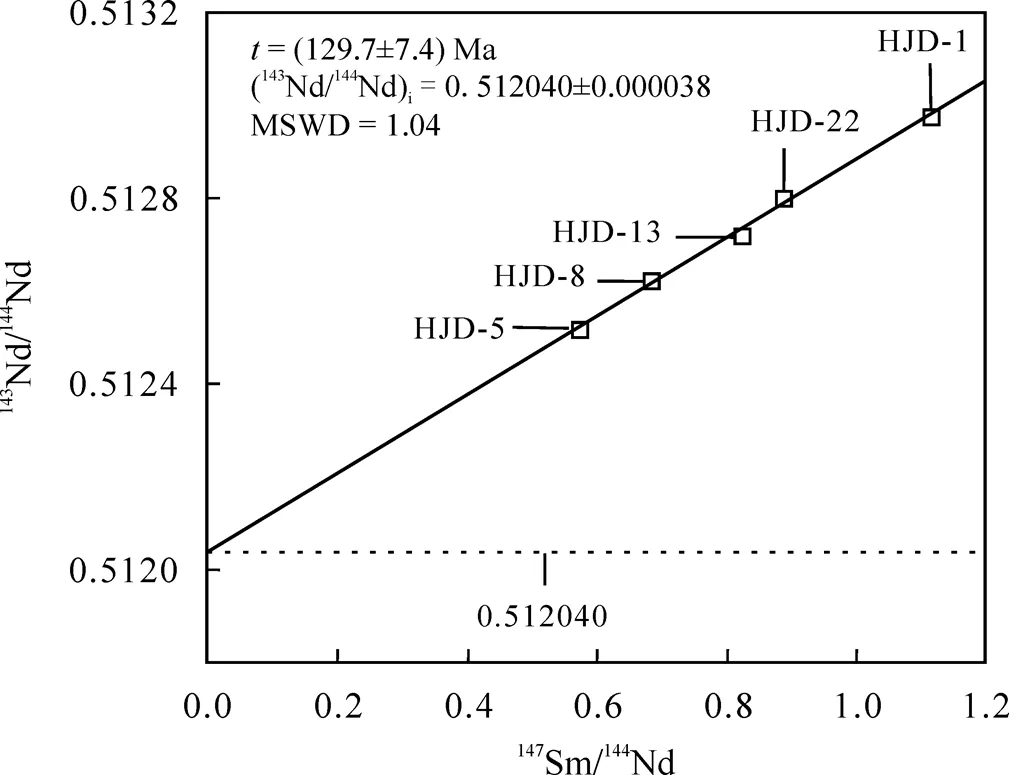
图5 湖南黄金洞金矿床白钨矿Sm-Nd等时线图
5.2 黄金洞金矿床白钨矿中Nd的来源
由于白钨矿从流体中结晶时, Nd同位素不会受到影响[78], 白钨矿的Nd同位素被广泛运用于源区示踪的工作[1,11,30,78,79]。本次测得黄金洞金矿床中白钨矿的Nd()值位于−8.21~−8.68之间, 表明Nd同位素为壳源。根据毛景文等[38]的Sm-Nd同位素数据, 重新计算得赋矿地层冷家溪群的Nd(129.7 Ma)值分布于−10.30 ~ −13.86之间, 小于白钨矿的Nd()值。矿区外围出露的时代更老的仓溪岩群的Nd(129.7 Ma)值分布于−5.80 ~ −8.06之间[80], 大于白钨矿的Nd()值。同时, 湘东北地区早白垩世的S型花岗岩的Nd(129 Ma)值分布于−10.02 ~ −10.36之间(中南大学未发表数据) (图6)。这表明, 白钨矿中的Nd可能部分来自于冷家溪群和(或)湘东北早白垩世的花岗岩, 部分来自于新元古界仓溪岩群。
5.3 黄金洞金矿床的成因
在黄金洞金矿区, 切穿第一阶段无矿石英的白云母的Ar-Ar年龄为397~399 Ma[81], 表明东西向‒北西西向的赋矿构造形成于加里东期或更早。同样赋存于东西向‒北西西向赋矿构造中的第二阶段白钨矿的Sm-Nd等时线年龄为(129.7±7.4) Ma, 表明赋矿构造在燕山期发生了活化。前人研究表明, 向华南板块俯冲的古太平洋板块发生后撤, 进而导致整个华南地区的应力体系由挤压向伸展转换的时间也为130 Ma左右[52,82], 与黄金洞金矿床的成矿年龄在误差范围内一致。因此, 可能是这次构造事件导致了湘东北地区构造的活化, 从而为黄金洞金矿床的成矿流体提供了运移的通道和成矿的空间。

图6 黄金洞金矿区白钨矿与湘东北各地质体εNd(t)值对比图
新元古界仓溪岩群的Nd() (=129.7 Ma)根据文献[80]重新计算; 新元古界冷家溪群的Nd() (=129.7 Ma)根据文献[38]重新计算; 湘东北早白垩世花岗岩的Nd() (=129 Ma)数据引自中南大学未发表数据
Nd() (=129.7 Ma) for the Neoproterozoic Cangxiyan Group was calculated according to reference [80];Nd() (=129.7 Ma) for the Neoproterozoic Lengjiaxi Group was calculated according to reference [38], whileNd() (=129 Ma) for early Cretaceous granites in northeastern Hunan was cited from unreleased data of Central South University
5.4 对江南造山带金锑钨成矿作用的启示
在江南造山带上, 绝大多数金锑钨矿床赋存于新元古界地层之中[36,77]。S和Pb同位素分析结果表明, 这些矿床的成矿物质主要来源于赋矿的新元古界(文献[36]及其参考文献)。同时, 元素含量分析结果表明, 新元古界(尤其是冷家溪群)的Au、Sb和W的含量高于地壳丰度值[38,54]。因此, 江南造山带上绝大多数金锑钨矿床的矿源层应为新元古界, 各个矿床成矿时代不一致可能是因为成矿物质被活化、迁移、沉淀成矿的时间不同所导致的。
关于引起矿源层中成矿元素活化的因素, 有学者认为是大规模的造山作用[25,93–96]和(或)区域变质作用[97–100]。针对江南造山带金锑钨矿床的成矿年代学研究结果显示, 不论是加里东期、印支期还是燕山期, 在江南造山带的西南段、中段和北东段通常都有相近的年龄(不论是成矿年龄还是无矿的热液活动年龄)出现(表2, 图7)。因此, 大规模的造山作用和(或)区域变质作用在引发江南造山带热液活动方面发挥了重要作用。江南造山带大部分金锑钨矿床的成矿流体主要为变质水[25,95,99,101–109]的现象也支持这个观点。
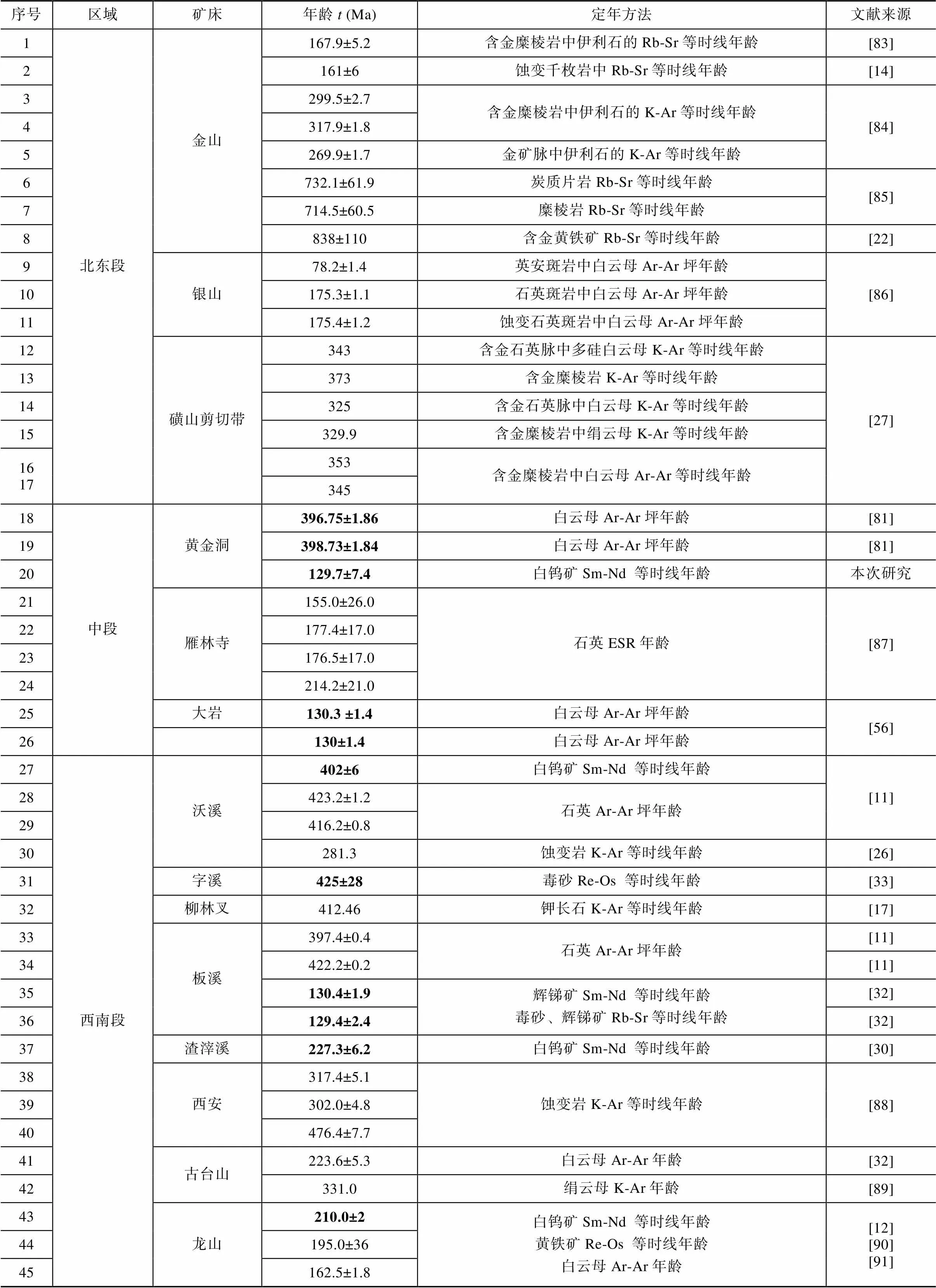
表2 江南造山带已报道和本文中的金锑钨矿床年龄统计表

(续表2)
粗体的年龄数据为“较可靠”的年龄; 其余为“较不可靠”的年龄。“较可靠”的年龄和“较不可靠”的年龄的定义见图7的说明。
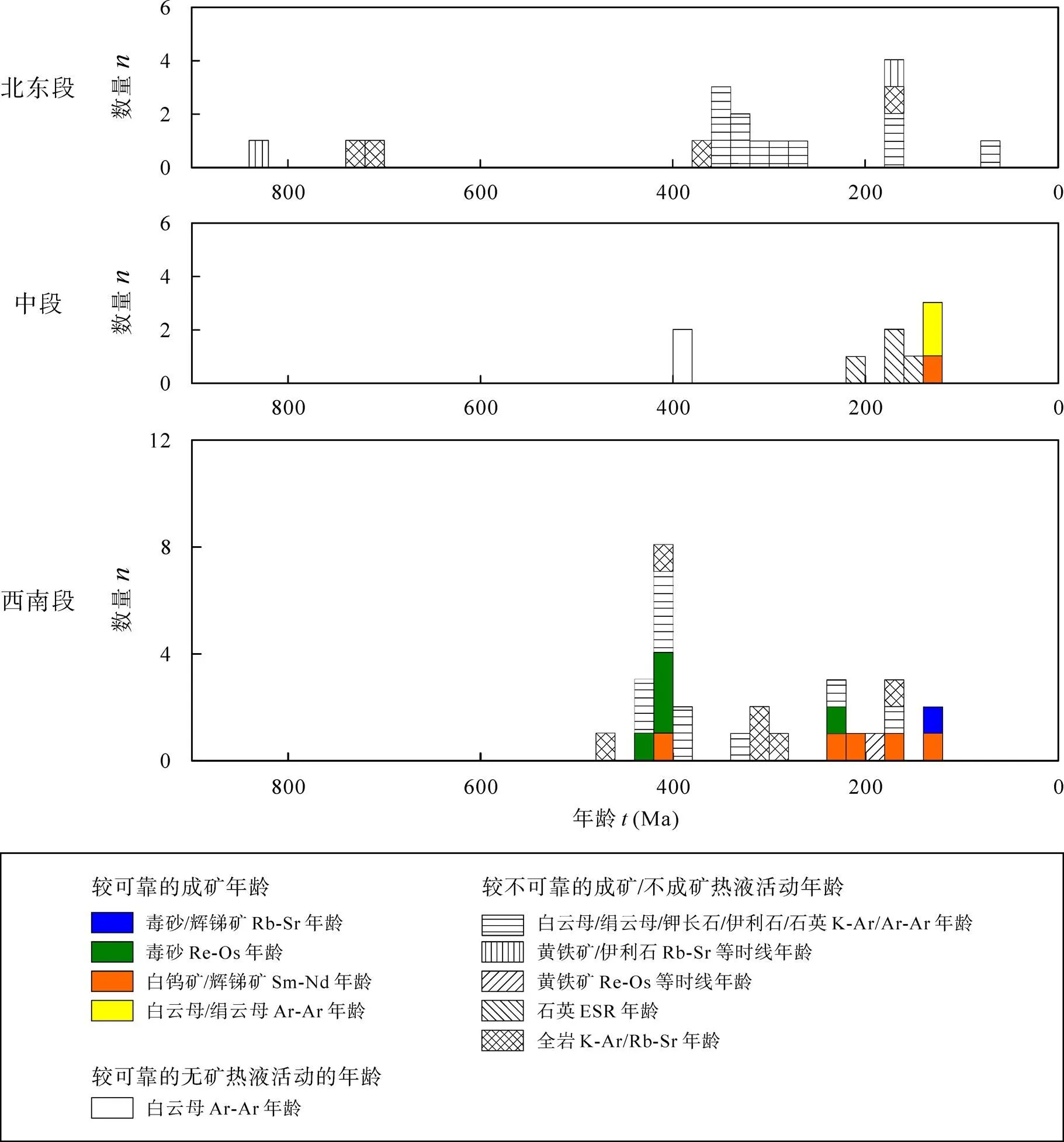
图7 江南造山带北东段、中段、西南段年龄对比图(年龄数据来自表2)
图中“较可靠”的年龄指对应的定年矿物的成因明确, 且与成矿阶段/无矿阶段的关系明确的年龄; “较不可靠”的年龄指对应的定年矿物成因不明, 或与成矿阶段/无矿阶段的关系不明的年龄。
Robust ages in the figure represent ages that were dated by minerals with specific genesis and relationship with ore-forming stage/barren stage;Less robust ages represent ages that were dated by minerals without specific genesis or relationship with ore-forming stage/barren stage.
同时, 江南造山带上的金锑钨矿床大多在空间上与岩浆岩相联系。部分矿区有岩体或岩脉出露(如龙山金锑矿床[12]); 部分矿区尽管没有岩体露头, 但被认为深部存在隐伏岩体(如大万金矿床[110]), 或其附近的北东向深大断裂沿线有岩体产出(如大万金矿床、黄金洞金矿床(图1b)和沃溪金锑钨矿床)。金锑钨矿床的成矿年龄通常与这些邻近岩体的年龄相近或稍晚。例如, 黄金洞金矿床的年龄((129.7±7.4) Ma)、大岩金矿化点的年龄(130 Ma)[56]略晚于长平断裂带沿线燕山期岩体的年龄(155~130 Ma)[49,56]; 龙山金锑矿床的年龄((210±2) Ma)[12]和渣滓溪锑钨矿床的年龄((227.3±6.2) Ma)[30]与附近晚三叠世岩体的年龄(228~201 Ma)[111]大致相等。氢氧同位素分析结果显示, 江南造山带金锑钨矿床的成矿流体中除了变质水外, 通常还有少量岩浆水的参与[102,104,106,107]。在湘东北地区, 还可观察到以连云山岩体为中心, 由近到远依次出现高温、中温和低温的成矿元素分带[38,39](图1)。以上这些证据表明, 岩浆作用也在成矿物质的活化过程中发挥了重要作用, 可能其提供的热能或带来的某些流体或物质有利于矿源层中成矿物质的活化。
此外,江南造山带上的金锑钨矿床大多受构造的控制, 产出于北东向深大断裂两侧的次级断裂中[41,77]。平秋[29,31]、金井[29,34]和黄金洞[81]等矿床同时存在着两个或多个年龄(表2)的现象表明, 控矿构造在形成后可能再次活化[36], 构造的活化可能为含矿流体的运移和沉淀成矿提供了通道和空间。
综上所述, 矿源层中金等成矿物质的活化可能是造山作用及其相关的区域变质作用和岩浆作用共同作用的结果, 而构造活化可能为含矿流体的运移和沉淀成矿提供了通道和空间。在某个特定的时期, 之所以部分地区成矿而部分地区不成矿, 一方面可能是不成矿地区区域变质作用和(或)岩浆作用的影响程度较低导致矿源层中的成矿物质没有被活化, 另一方面可能是不成矿地区缺乏构造活化提供的成矿流体运移的通道和沉淀成矿的空间。
5.5 对找矿工作的启示
本次研究表明, 在江南造山带的金锑钨成矿作用中, 新元古界地层是矿源层, 区域变质作用、岩浆作用和构造活化在成矿物质的活化、迁移和沉淀过程中起到了重要作用。因此, 在江南造山带的找矿工作中, 可将新元古界地层、火成岩和活化的构造作为重要的预测要素。
6 结 论
(1) 黄金洞金矿床的成矿年龄为(129.7±7.4) Ma;
(2) 黄金洞金矿床白钨矿中的Nd部分来自新元古界冷家溪群和(或)湘东北早白垩世的花岗岩, 部分来自新元古界仓溪岩群;
(3) 在江南造山带上, 新元古界地层为金锑钨矿床的矿源层, 区域变质作用和岩浆作用的综合作用可能为新元古界地层中金等成矿物质的活化提供了必要条件, 构造的活化可能为含矿热液提供了运移通道的和沉淀成矿的空间。
中国地质大学(武汉)蒋少涌教授和中国地质科学院地质研究所周利敏副研究员对本文的初稿提出了宝贵的修稿意见, 在此表示衷心的感谢!
[1] Bell K, Anglin C D, Franklin J M. Sm-Nd and Rb-Sr isotope systematics of scheelites: Possible implications for the age and genesis of vein-hosted gold deposits[J]. Geology, 1989, 17(6): 500–504.
[2] 陆松年, 李怀坤, 李惠民. 成矿地质事件的同位素年代学研究[J]. 地学前缘, 1999, 6(2): 335–342.
Lu Song-nian, Li Huai-kun, Li Hui-min. Research on isotopic geochronology of mineralization events[J]. Geosci Front, 1999, 6(2): 335–342 (in Chinese with English abstract).
[3] Fryer B J, Taylor R P . Sm-Nd direct dating of the Collins Bay hydrothermal uranium deposit, Saskatchewan[J]. Geology, 1984, 12(8): 479–482.
[4] Surya Prakash Rao K, Sastry R S N, Raju S V. Scheelite as a prospecting tool for gold in the Ramagiri greenstone belt, Andhra Pradesh, India[J]. J Geochem Explor, 1989, 31(3): 307–317.
[5] Ghaderi M, Palin J M, Campbell I H, Sylvester P J. Rare earth element systematics in scheelite from hydrothermal gold deposits in the Kalgoorlie-Norseman region, Western Australia[J]. Econ Geol, 1999, 94(3): 423–437.
[6] Boyle R W. The geochemistry of gold and its deposits[J]. Geol Surv Can Bull, 1979, 280: 579–584.
[7] Raimbault L, Baumer A, Dubru M, Benkerrou C, Croze V, Zahm A. REE fractionation between scheelite and apatite in hydrothermal conditions[J]. Am Mineral, 1993, 78: 1275–1285.
[8] Brugger J L, Etschmann B, Pownceby M, Liu W, Grundler P, Brewe D. Oxidation state of europium in scheelite: Tracking fluid-rock interaction in gold deposits[J]. Mineral Mag, 2008, 257(1/2): 0–33.
[9] Anglin C D, Jonasson I R, Franklin J M. Sm-Nd dating of scheelite and tourmaline; implications for the genesis of Archean gold deposits, Val d’Or, Canada[J]. Econ Geol, 1996, 91(8): 1372–1382.
[10] Darbyshire D P F, Pitfield P E J, Campbell S D G. Late Archean and Early Proterozoic gold-tungsten mineralization in the Zimbabwe Archean craton: Rb-Sr and Sm-Nd isotope constraints[J]. Geology, 1996, 24(1): 19–22.
[11] 彭建堂, 胡瑞忠, 赵军红, 符亚洲, 林源贤. 湘西沃溪Au-Sb-W矿床中白钨矿Sm-Nd和石英Ar-Ar定年[J]. 科学通报, 2003, 48(18): 1976–1981.
Peng Jian-tang, Hu Rui-zhong, Zhao Jun-hong, Fu Ya-zhou, Lin Yuan-xian. Scheelite Sm-Nd dating and quartz Ar-Ar dating from the Woxi Au-Sb-W deposit, western Hunan China[J]. Chinese Sci Bull, 2003, 48(18): 1976–1981 (in Chinese).
[12] Zhang Z Y, Xie G Q, Mao J W, Liu W G, Olin P, Li W. Sm-Nd Dating and in-situ LA-ICP-MS trace element analyses of scheelite from the Longshan Sb-Au deposit, Xiangzhong metallogenic province, South China[J]. Minerals, 2019, 9: doi: 10.3390/ min9020087
[13] 史明魁, 傅必勤, 靳西祥. 湘中锑矿[M]. 长沙: 湖南科技出版社, 1994: 1–151.
Shi Ming-kui, Fu Bi-qin, Jin Xi-xiang. Antimony metallogeny in central part of Hunan Province [M]. Changsha: Hunan Science and Technology Press, 1994: 1–151 (in Chinese with English abstract).
[14] 张金春. 江西金山韧性剪切型金矿成矿地球化学研究[D]. 南京: 南京大学, 1994.
Zhang Jin-chun. Metallogenic and geochemistry of Jinshan ductile shear-type gold deposit, Jiangxi Province [D]. Nanjing: Nanjing University, 1994 (in Chinese with English abstract).
[15] 陈好寿, 徐步台. 浙江璜山金矿床同位素地球化学研究[J]. 浙江地质, 1996, 12(1): 74–82.
Chen Hao-shou, Xu Bu-tai. Isotope geochemical study on the Huangshan gold deposit, Zhejiang[J]. Geol of Zhejiang, 1996, 12(1): 74–82 (in Chinese with English abstract).
[16] 彭建堂, 戴塔根. 雪峰地区金矿成矿时代问题的探讨[J]. 地质与勘探, 1998, 34(4): 37–41.
Peng Jian-tang, Dai Ta-gen. On the mineralization epoch of the Xuefeng gold metallogenic province[J]. Geol Prosp, 1998, 34(4): 37–41 (in Chinese with English abstract).
[17] 王秀璋, 梁华英, 单强, 程景平, 夏萍. 金山金矿成矿年龄测定及华南加里东成金期的讨论[J]. 地质论评, 1999, 45(1): 19–25.
Wang Xiu-zhang, Liang Hua-ying, Shan Qiang, Cheng Jing-ping, Xia Ping. Metallogenic age of the Jinshan gold deposit and Caledonian gold mineralization in South China[J]. Geol Rev, 1999, 45(1): 19–25 (in Chinese with English abstract).
[18] 朱笑青, 王甘露, 卢焕章, 吴学益, 陈文益. 黔东南金矿形成时代的确定兼论湘黔加里东金矿带[J]. 中国地质, 2006, 33(5): 1092–1099.
Zhu Xiao-Qing, Wang Gan-lu, Lu Huan-zhang, Wu Xue-yi, Chen Wen-yi. Determination of the age of gold deposits in southeastern Guizhou: With a discussion of the Caledonian Hunan-Guizhou gold ore belt[J]. Chinese Geol, 2006, 33(5): 1092–1099 (in Chinese with English abstract).
[19] 陈富文, 戴平云, 梅玉萍, 李华芹, 王登红, 蔡红. 湖南雪峰山地区沈家垭金矿成矿学及年代学研究[J]. 地质学报, 2008, 82(7): 906–911.
Chen Fu-wen, Dai Ping-yun, Mei Yu-ping, Li Hua-qin, Wang Deng-hong, Cai Hong. Metallogenetic and isotopic chronological study on the Shenjiaya gold deposit in Xuefeng Mountains, Hunan Province[J]. Acta Geol Sinica, 2008, 82(7): 906–911 (in Chinese with English abstract).
[20] 董国军, 许德如, 王力, 陈广浩, 贺转利, 符巩固, 吴俊, 王智琳. 湘东地区金矿床矿化年龄的测定及含矿流体来源的示踪——兼论矿床成因类型[J]. 大地构造与成矿学, 2008, 32(4): 482–491.
Dong Guo-jun, Xu De-ru, Wang Li, Chen Guang-hao, He Zhuan-li, Fu Gong-gu, Wu Jun, Wang Zhi-lin. Determination of mineralizing ages on gold ore deposits in the eastern Hunan province, south China and isotopic tracking on ore-forming fluids re-discussing gold ore deposit type[J]. Geotecton Metallogen, 2008, 32(4): 482–491 (in Chinese with English abstract).
[21] 李华芹, 王登红, 陈富文, 梅玉萍, 蔡红. 湖南雪峰山地区铲子坪和大坪金矿成矿作用年代学研究[J]. 地质学报, 2008, 82(7): 900–905.
Li Hua-qin, Wang Deng-hong, Chen Fu-wen, Mei Yu-ping, Cai Hong. Study on chronology of the Chanziping and Daping gold deposit in Xuefeng Mountains, Hunan Province[J]. Acta Geol Sinica, 2008, 82(7): 900–905 (in Chinese with English abstract).
[22] 毛光周, 华仁民, 龙光明, 陆慧娟. 江西金山金矿成矿时代探讨——来自石英流体包裹体Rb-Sr年龄的证据[J]. 地质学报, 2008, 82(4): 532–539.
Mao Guang-zhou, Hua Ren-min, Long Guang-ming, Lu Hui-juan. Rb-Sr age of gold-bearing pyrite in the Jinshan gold deposit, Jiangxi Province[J]. Acta Geol Sinica, 2008, 82(4): 532–539 (in Chinese with English abstract).
[23] 韩凤彬, 常亮, 蔡明海, 刘孙泱, 张诗启, 陈艳, 彭振安, 徐明. 湘东北地区金矿成矿时代研究[J]. 矿床地质, 2010, 29(3): 563–571.
Han Feng-bin, Chang Liang, Cai Ming-hai, Liu Sun-yang, Zhang Shi-qi, Chen Yan, Peng Zhen-an, Xu Ming. Ore-forming epoch of gold deposits in northeastern Hunan[J]. Mineral Deposits, 2010, 29(3): 563–571 (in Chinese with English abstract).
[24] 卢新哲. 遂昌治岭头金矿矿床地质特征和成矿作用研究[D]. 合肥: 合肥工业大学, 2014.
Lu Xin-zhe. Study on Suichang Zhilingtou deposit geological feature and mineralization [D]. Hefei: Hefei University of Technology, 2014 (in Chinese with English abstract).
[25] Ni P, Wang G G, Chen H, Xu Y F, Guan S J, Pan J Y, Li L. An Early Paleozoic orogenic gold belt along the Jiang-Shao Fault, South China: Evidence from fluid inclusions and Rb-Sr dating of quartz in the Huangshan and Pingshui deposits[J]. J Asian Earth Sci, 2015, 103: 87–102.
[26] 罗献林. 论湖南前寒武纪系金矿床的形成时代[J]. 桂林冶金地质学院学报, 1989, 9(1): 25–34.
Luo Xian-lin. On the epoch of the formation of Precambrian gold deposits in Hunan Province[J]. J Guilin Colleg Geol, 1989, 9(1): 25–34 (in Chinese with English abstract).
[27] 叶有钟, 叶桂顺, 赵关连, 柏庆如. 浙江诸暨璜山地区金(银)矿成矿时代探讨[J]. 浙江地质, 1993, 9(2): 10–14.
Ye You-zhong, Ye Gui-shun, Zhao Guan-lian, Bai Qing-ru. Discussion on mineralization period of gold (silver) deposits in Huangshan district of Zhuji, Zhejiang Province[J]. Geol of Zhejiang, 1993, 9(2): 10–14 (in Chinese with English abstract).
[28] 胡瑞英, 程景平, 郭士伦, 郝秀红. 裂变径迹法在金矿研究中的应用[J]. 地球化学, 1995, 24(2): 188–192.
Hu Rui-ying, Cheng Jing-ping, Guo Shi-lun, Hao Xiu-hong. Application of fission track technique to study of gold deposits[J]. Geochimica, 1995, 24(2): 188–192 (in Chinese with English abstract).
[29] 王加昇, 温汉捷, 李超, 丁伟, 张锦让. 黔东南石英脉型金矿毒砂Re-Os同位素定年及其地质意义[J]. 地质学报, 2011, 85(6): 955–964.
Wang Jia-sheng, Wen Han-jie, Li Chao, Ding Wei, Zhang Jin-rang. Re-Os isotope dating of arsenopyrite from the quartz vein-type gold deposit, southeastern Guizhou Province, and its geological implications[J]. Acta Geol Sinica, 2011, 85(6): 955–964 (in Chinese with English abstract).
[30] 王永磊, 陈毓川, 王登红, 徐珏, 陈郑辉. 湖南渣滓溪W-Sb矿床白钨矿Sm-Nd测年及其地质意义[J]. 中国地质, 2012, 39(5): 1339–1344.
Wang Yong-lei, Chen Yu-chuan, Wang Deng-hong, Xu Yu, Chen Zheng-hui. Scheelite Sm-Nd dating of the Zhazixi W-Sb deposit in Hunan and its geological significance[J]. Chinese Geol, 2012, 39(5): 1339–1344 (in Chinese with English abstract).
[31] 顾尚义, 杜定全, 付勇, 孙士军, 李超. 江南造山带西南缘石英脉型金矿中毒砂Re-Os同位素定年研究[J]. 岩矿测试, 2016, 35(5): 542–549.
Gu Shang-yi, Du Ding-quan, Fu Yong, Sun Shi-jun, Li Chao. Re-Os isotopic dating of arsenopyrite from auriferous quartz vein-type gold deposits in the southwestern margin of Jiangnan Orogen[J]. Rock Mineral Anal, 2016, 35(5): 542–549 (in Chinese with English abstract).
[32] Li H, Wu Q H, Evans N J, Zhou Z K, Lin Z W. Geochemistry and geochronology of the Banxi Sb deposit: Implications for fluid origin and the evolution of Sb mineralization in central-western Hunan, South China[J]. Gondw Res, 2017, 55: 112–134.
[33] Wang C, Shao Y J, Evans N J, Li H, Zhou H D, Huang K X, Liu Z F, Chen Y, Lai C, Liu Q Q. Genesis of Zixi gold deposit in Xuefengshan, Jiangnan Orogen (South China): Age, geology and isotopic constraints[J]. Ore Geol Rev, 2020, 117: 103301. doi: 10.1016/j.oregeorev.2019.103301
[34] Wang J S, Wen H J, Li C, Zhang J R, Ding W. Age and metal source of orogenic gold deposits in Southeast Guizhou Province, China: Constraints from Re-Os and He-Ar isotopic evidence[J]. Geosci Front, 2019, 10(2): 581–593.
[35] Deng T, Xu D, Chi G, Zhu Y, Wang Z, Chen G, Li Z, Zhang J, Ye T, Yu D. Revisiting the ca. 845–820-Ma S-type granitic magmatism in the Jiangnan Orogen: new insights on the Neoproterozoic tectono-magmatic evolution of South China[J]. International Geology Review, 2019, 61(6): 383–403.
[36] Xu D R, Deng T, Chi G X, Wang Z L, Zou F H, Zhang J L, Zou S H. Gold mineralization in the Jiangnan Orogenic Belt of South China: Geological, geochemical and geochronological characteristics, ore deposit-type and geodynamic setting[J]. Ore Geology Reviews, 2017, 88: 565–618.
[37] Sun W D, Yang X Y, Fan W M, Wu F Y. Mesozoic large scale magmatism and mineralization in South China: Preface[J]. Lithos, 2012, 150(Complete): 1–5.
[38] 毛景文, 李红艳, 徐钰, 罗福庭. 湖南万古地区金矿地质与成因[M]. 北京: 原子能出版社, 1997.
Mao Jing-wen, Li Hong-yan, Xu Yu, Luo Fu-ting. Geology and genesis of the Wangu gold deposit in Hunan province, China[M]. Beijing: Atomic energy press, 1997 (in Chinese with English abstract).
[39] 许德如, 邓腾, 董国军, 宁钧陶, 王智琳, 张俊岭, 邹凤辉, 周岳强, 陈根文, 周永章, 林舸. 湘东北连云山二云母二长花岗岩的年代学和地球化学特征: 对岩浆成因和成矿地球动力学背景的启示[J]. 地学前缘, 2017, 24(2): 104–122.
Xu De-ru, Deng Teng, Dong Guo-jun, Ning Jun-tao, Wang Zhi-lin, Zhang Jun-ling, Zou Feng-hui, Zhou Yue-qiang, Chen Gen-wen, Zhou Yong-zhang, Lin Ge. Zircon U-Pb geochronological and geochemical characteristics of the Lianyunshan two-mica monzogranites in northeastern Hunan Province: implications for petrogenesis and tectonic setting associated with polymetallic mineralization[J]. Geoscience Frontiers, 2017, 24(2): 104–122 (in Chinese with English abstract).
[40] 舒良树, 王德滋. 北美西部与中国东南部盆岭构造对比研究[J]. 高校地质学报, 2006, 12(1): 1–13.
Shu Liang-shu, Wang De-zi. Comparative study on basin and range structure in western North America and eastern China[J]. Geological Journal of China Universities, 2006, 12(1): 1–13 (in Chinese with English abstract).
[41] 许德如, 邹凤辉, 宁钧陶, 邓腾, 王智琳, 陈根文, 张建岭, 董国军. 湘东北地区地质构造演化与成矿响应探讨[J]. 岩石学报, 2017, 33(3): 695–715.
Xu De-ru, Zou Feng-hui, Ning Jun-tao, Deng Teng, Wang Zhi-lin, Chen Gen-wen, Zhang Jian-ling, Dong Guo-jun. Discussion on geological and structural characteristics and associated metallogeny in northeastern Hunan province, South China[J]. Acta Petrologica Sinica, 2017, 33(3): 695–715 (in Chinese with English abstract).
[42] Ye M F, Li X H, Li W X, Liu Y, Li Z X. SHRIMP zircon U–Pb geochronological and whole-rock geochemical evidence for an early Neoproterozoic Sibaoan magmatic arc along the southeastern margin of the Yangtze Block[J]. Gondwana Research, 2007, 12(1): 144–156.
[43] Faure M, Shu L S, Wang B, Charvet J, Choulet F, Monie P. Intracontinental subduction: a possible mechanism for the Early Palaeozoic Orogen of SE China[J]. Terra Nova, 2009, 21(5): 360–368.
[44] Xu X B, Li Y, Tang S, Xue D J, Zhang Z J. Neoproterozoic to Early Paleozoic polyorogenic deformation in the southeastern margin of the Yangtze Block: Constraints from structural analysis and 40Ar/39Ar geochronology[J]. Journal of Asian Earth Sciences, 2015, 98: 141–151.
[45] 孙涛. 新编华南花岗岩分布图及其说明[J]. 地质通报, 2006, 25(3): 332–335.
Sun Tao. A new map showing the distribution of granites in South China and its explanatory notes[J]. Geological Bulletin of China, 2006, 25(3): 332–335 (in Chinese with English abstract).
[46] Wang Y J, Fan W M, Sun M, Liang X Q, Zhang Y H, Peng T P. Geochronological, geochemical and geothermal constraints on petrogenesis of the Indosinian peraluminous granites in the South China Block: A case study in the Hunan Province[J]. Lithos, 2007, 96(3-4): 475–502.
[47] Li Z X. Tectonic History of the Major East Asian Lithospheric Blocks Since the Mid-Proterozoic — A Synthesis[M]. Washington: American Geophysical Union, 1998: 221–243.
[48] 王岳军, 范蔚茗, 梁新权, 彭头平, 石玉若. 湖南印支期花岗岩SHRIMP锆石U-Pb年龄及其成因启示[J]. 科学通报, 2005, 50(12): 101–108.
Wang Yue-jun, Fan Wei-ming, Liang Xin-quan, Peng Tou-ping, Shi Yu-ruo. SHRIMP zircon U-Pb geochronology of Indosiniangranites in Hunan Province and its petrogenetic implications[J]. Chinese Science Bulletin, 2005, 50(12): 101–108 (in Chinese with English abstract).
[49] Li J H, Dong S W, Zhang Y Q, Zhao G C, Johnston S T, Cui J J, Xin Y J. New insights into Phanerozoic tectonics of south China: Part 1, polyphase deformation in the Jiuling and Lianyunshan domains of the central Jiangnan Orogen[J]. Journal of Geophysical Research Solid Earth, 2016, 121(4): 3048–3080.
[50] Chen C H, Lee C Y, Shinjo R. Was there Jurassic paleo-Pacific subduction in South China?: Constraints from 40Ar/39Ar dating, elemental and Sr–Nd–Pb isotopic geochemistry of the Mesozoic basalts[J]. Lithos, 2008, 106(1-2): 83–92.
[51] Jiang Y H, Jiang S Y, Dai B Z, Liao S Y, Zhao K D, Ling H F. Middle to late Jurassic felsic and mafic magmatism in southernHunan province, southeast China: Implications for a continental arc to rifting[J]. Lithos, 2009, 107(3-4): 185–204.
[52] Li J H, Zhang Y Q, Dong S W, Johnston S T. Cretaceous tectonic evolution of South China: A preliminary synthesis[J]. Earth-Science Reviews, 2014, 134(1): 98–136 (in Chinese with English abstract).
[53] 柏道远, 钟响, 贾朋远, 熊雄, 黄文义, 姜文. 雪峰造山带及邻区构造变形和构造演化研究新进展[J]. 华南地质与矿产, 2015, 31(04): 3–25.
Bai Dao-yuan, Zhong Xiang, Jia Peng-yuan, Xiong Xiong, Huang wen-yi, Jiang Wen. Progresses in the deformations and tectonic evolutions of the Xuefeng Orogenic Belt and its adjacent areas[J]. Geology and Mineral Resources of South China, 2015, 31(04): 3–25 (in Chinese with English abstract).
[54] 朱炎龄, 李崇佑, 林运淮. 赣南钨矿地质[M]. 南昌: 江西人民出版社, 1981.
Zhu Yan-ling, Li Chong-you, Lin Yun-huai. Geology of Tungsten deposit[M]. Nanchang: Jiangxi People's Publishing House, 1981 (in Chinese with English abstract).
[55] 肖拥军, 陈广浩. 湘东北大洞-万古地区金矿构造成矿定位机制的初步研究[J]. 大地构造与成矿学, 2004, 28(1): 38–44.
Xiao Yong-jun, Chen Guang-hao. Preliminary study on the tectono-metallogenic orientation mechanism of the Dadong-Wangu gold deposit zone, northeastern Hunan province[J]. Geotectonica et Metallogenia, 2004, 28(1): 38–44 (in Chinese with English abstract).
[56] Deng T, Xu D R, Chi G X, Wang Z L, Jiao Q Q, Ning J T, Dong G J, Zou F H. Geology, geochronology, geochemistry and ore genesis of the Wangu gold deposit in northeastern Hunan Province, Jiangnan Orogen, South China[J]. Ore Geology Reviews, 2017, 88: 619–637.
[57] Li X H, Li Z X, Ge W C, Zhou H W, Li W X, Liu Y. U-Pb zircon ages of the Neoproterozoic granitoids in South China and their tectonic implications[J]. Bulletin of Mineralogy, Petrology and Geochemistry, 2001, 20(4): 271-273.
[58] 钟玉芳, 马昌前, 佘振兵, 林广春, 续海金, 王人镜, 杨坤光, 刘强. 江西九岭花岗岩类复式岩基锆石 SHRIMP U-Pb年代学[J]. 地球科学, 2005, 030(6): 685–691.
Zhong Yu-fang, Ma Chang-qian, She Zhen-bing, Lin Guang-chun, Xu Hai-jin, Wang Ren-jing, Yang Kun-guang, Liu Qiang. SHRIMP U-Pb Zircon Geochronology of the Jiuling Granitic Complex Batholith in Jiangxi Province[J]. Earth Science, 2005, 30(6): 685–691 (in Chinese with English abstract).
[59] 马铁球, 陈立新, 柏道远, 周柯军, 李纲, 王先辉. 湘东北新元古代花岗岩体锆石SHRIMP U-Pb年龄及地球化学特征[J]. 中国地质, 2009, 36(1): 65–73.
Ma Tie-qiu, Chen Li-xin, Bai Dao-yuan, Zhou Ke-jun, Li Gang, Wang Xian-hui. Zircon SHRIMP dating and geochemical characteristics of Neoproterozoic granites in southeastern Hunan[J]. Chinese Geology, 2009, 36(1): 65–73 (in Chinese with English abstract).
[60] Wang X L, Zhou J C, Qiu J S, Gao J F. Geochemistry of the Meso- to Neoproterozoic basic-acid rocks from Hunan Province, South China: implications for the evolution of the western Jiangnan orogen[J]. Precambrian Research, 2004, 135(1): 79–103.
[61] 李鹏春, 陈广浩, 许德如, 贺转利, 符巩固. 湘东北新元古代过铝质花岗岩的岩石地球化学特征及其成因讨论[J]. 大地构造与成矿学, 2007, 31(1): 126–136.
Li Peng-chun, Chen Guang-hao, Xu De-ru, He Zhuan-li, Fu Gong-gu. Petrological and geochemical characteristics and petrogenesis of Neoproterozoic peraluminous granites in northeastern Hunan Province[J]. Geotectonica et Metallogenia, 2007, 31(1): 126–136 (in Chinese with English abstract).
[62] 关义立, 袁超, 龙晓平, 王毓婧, 张运迎, 黄宗莹. 华南地块东部早古生代的陆内造山作用: 来自I型花岗岩的启示[J].大地构造与成矿学, 2013, 37(4): 698–720.
Guang Yi-li, Yuan Chao, Long Xiao-ping, Wang Yu-jin, Zhang Yun-ying, Huang Zong-ying. Early Paleozoic Intracontinental Orogeny of the Eastern South China Block: Evidence from I-type Granitic Plutons in the SE Yangtze Block[J]. Geotectonicaet Metallogenia, 2013, 37(4): 698–720 (in Chinese with English abstract).
[63] 许德如, 陈广浩, 夏斌, 李鹏春, 贺转利. 湘东地区板杉铺加里东期埃达克质花岗闪长岩的成因及地质意义[J]. 高校地质学报, 2006, 12(4): 507–521.
Xu De-ru, Chen Guang-hao, Xia Bin, Li Peng-chun, He Zhuan-li. The Caledonian Adakite-Like Granodiorites in Banshanpu Area, Eastern Hunan Province, South China: Petrogenesis and Geological Significance[J]. Geological Journal of China Universities, 2006, 12(4): 507–521 (in Chinese with English abstract).
[64] 邓腾. 湘东北地区陆内构造-岩浆活化及其对金成矿作用的控制[D]. 广州: 中国科学院广州地球化学研究所, 2018.
Deng Teng. Introcontinental tectono-magmatic reactivation and its control over gold mineralization in Northeastern Hunan Province, South China[D]. Guangzhou: Guangzhou Institute of Geochemistry, Chinese Academy of Sciences, 2018 (in Chinese with English abstract).
[65] 李鹏春. 湘东北地区显生宙花岗岩岩浆作用及其演化规律[D]. 广州: 中国科学院广州地球化学研究所, 2006.
Li Peng-chun. Magmatism of Phanerozoic granitoids in southeastern Hunan Province, China and its evolution regularity[D]. Guangzhou: Guangzhou Institute of Geochemistry, Chinese Academy of Sciences, 2006 (in Chinese with English abstract).
[66] Zhang L, Groves D I, Yang L Q, Sun S C, Weinberg R F, Wang J Y, Wu S G, Gao L, Yuan L L, Li R H. Utilization of pre-existing competent and barren quartz veins as hosts to later orogenic gold ores at Huangjindong gold deposit, Jiangnan Orogen, southern China[J].Mineralium Deposita, 2019.
[67] 刘英俊, 孙承辕, 崔卫东, 季峻峰. 湖南黄金洞金矿床毒砂中金的赋存状态的研究[J]. 地质找矿论丛, 1989, 4(1): 42–49.
Liu Ying-jun, Sun Cheng-yuan, Cui Wei-dong, Ji Jun-feng. Study of the occurrence of gold in arsenopyrite of Huangjindong gold deposit in Hunan Province[J]. Contributions To Geology and Mineral Resources Research, 1989, 4(1): 42–49 (in Chinese with English abstract).
[68] 张文兰, 胡文宣, 胡受奚, 周顺之, 陈钢. 湖南黄金洞金矿毒砂中Au赋存状态的电子探针研究[J]. 高校地质学报, 1997, 3(3): 17–23.
Zhang Wen-lan, Hu Wen-xuan, Hu Shou-xi, Zhou Shun-zhi, Chen Gang. Study of the mode of gold in arsenopyrite from Huangjindong gold deposit, Hunan, by using electron probe microanalysis[J]. Geological Journal of China Universities, 1997, 3(3): 17–23 (in Chinese with English abstract).
[69] 李华芹. 新疆北部有色贵金属矿床成矿作用年代学[M]. 北京: 地质出版社, 1998: 1–266.
Li Hua-qin. Geochronology of mineralization of nonferrous and precious metal deposits in Northern Xinjiang[M]. Beijing: Geological Publishing House, 1998: 1–266 (in Chinese with English abstract).
[70] Ludwig K R. Isoplot 3.0–A Geochronological Toolkit for Microsoft Excel[M]. Berkeley, CA, USA: Berkeley Geochronology Center Special Publication, 2003.
[71] Steiger R H, Jager E. Subcommission on geochronology: Convention on the use of decay constants in geo- and cosmochronology[J]. Earth and Planetary Science Letters, 1977.
[72] Goldfarb R J, Baker T, Dubé B, Groves D I, Hart C J, Gosselin P. Distribution, Character, and Genesis of Gold Deposits in Metamorphic Terranes[J]. Economic Geology, 2005, Economic Geology 100th Anniversary Volume: 407–450.
[73] Mueller A G. The Savage Lode magnesian skarn in the Marvel Loch gold–silver mine, Southern Cross greenstone belt, WesternAustralia[J]. Canadian Journal of Earth Sciences, 1991, 62(28): 659–685.
[74] Beaudoin G, Pitre D. Stable isotope geochemistry of the Archean Val-d‘Or (Canada) orogenic gold vein field[J]. Mineralium Deposita, 2005, 40(1): 59–75.
[75] Graupner T, Niedermann S, Rhede D, Kempe U, Seltmann R, Williams C T, Klemd R. Multiple sources for mineralizing fluids in the Charmitan gold(-tungsten) mineralization (Uzbekistan)[J]. Mineralium Deposita, 2010, 45(7): 667–682.
[76] Kempe U O T. Physical and geochemical characteristics of scheelite from gold deposits: A reconnaissance study[M]. Rotterdam: Brookfield, 1997.
[77] Zhang L, Yang L Q, Groves D I, Sun S C, Liu Y, Wang J Y, Li R H, Wu S G, Gao L, Guo J L, Chen X G, Chen J H. An overview of timing and structural geometry of gold, gold-antimony and antimony mineralization in the Jiangnan Orogen, southern China[J]. Ore Geology Reviews, 2019: doi: https: //doi.org/10. 1016/j.oregeorev.2019.103173.
[78] Voicu G, Bardoux M, Stevenson R, Jébrak M. Nd and Sr isotope study of hydrothermal scheelite and host rocks at Omai, Guiana Shield: Implications for ore fluid source and flow path during the formation of orogenic gold deposits[J]. Mineralium Deposita, 2000, 35(4): 302–314.
[79] Kempe U, Belyatsky B, Krymsky R, Kremenetsky A, Ivanov P. Sm–Nd and Sr isotope systematics of scheelite from the giant Au(–W) deposit Muruntau (Uzbekistan): implications for the age and sources of Au mineralization[J]. Mineralium Deposita, 2001, 36(5): 379–392.
[80] 唐晓珊, 贾宝华, 黄建中, 彭和求, 郭乐群, 何江南. 湖南早前寒武纪变质结晶基底的Sm-Nd同位素年龄[J]. 华东地质, 2004, 25(1): 55–63.
Tang Xiao-shan, Jia Bao-hua, Huang Jian-zhong, Peng Qiu-he, Guo Le-qun, He Jiang-nan. The Sm-Nd isochron ages of the early Precambrian metamorphic crystalline basement in Hunan[J]. Resources Survey and Environment, 2004, 25(1): 55–63 (in Chinese with English abstract).
[81] Deng T, Xu D R, Chi G X, Wang Z L, Chen G W, Zhou Y Q, Li Z H, Ye T W, Yu D S. Caledonian (Early Paleozoic) veins overprinted by Yanshanian (Late Mesozoic) gold mineralization in the Jiangnan Orogen: A case study on gold deposits in northeastern Hunan, South China[J]. Ore Geology Reviews, 2018.
[82] Zhou X M, Li W X. Origin of Late Mesozoic igneous rocks in Southeastern China: Implications for lithosphere subduction and underplating of mafic magmas[J]. Tectonophysics, 2000, 326(3): 269–287.
[83] 吕赟珊, 解国爱, 倪培, 刘家润, 赵葵东, 董伟明. 赣东北金山金矿床构造变形特征及其区域构造意义[J]. 大地构造与成矿学, 2012, 36(4): 504–517.
Lv Yun-shan, Xie Guo-ai, Ni Pei, Liu Jia-run, Zhao Kui-dong, Dong Wei-ming. Structural deformation in the Jinshan gold deposit and its implication to the Tectonic evolution of the northeastern Jiangxi Province[J]. Geotectonica et Metallogenia, 2012, 36(4): 504–517 (in Chinese with English abstract).
[84] 李晓峰, 华仁民, 杨凤根, 高剑峰. 金山金矿K-Ar年龄及其对赣东北构造演化的指示意义[J]. 岩石矿物学杂志, 2002, 21(1): 49–54.
Li Xiao-feng, Hua Ren-min, Yang Feng-gen, Gao Jian-feng. K-Ar age of illite in Jinshan gold deposit and its implication to the tectonic evolution of northeastern Jiangxi Province[J]. Acta Petrologica et Mineralogica, 2002, 21(1): 49–54 (in Chinese with English abstract).
[85] 韦星林. 江西金山韧性剪切带型金矿地质特征[J]. 江西地质, 1996, (1): 52–64.
Wei Xinglin. The geological characteristics of Jinshan shear ductile shear zone type gold deposit in Jiangxi province[J]. Jiangxi Geology, 1996, (1): 52–64 (in Chinese with English abstract).
[86] 李晓峰, 陈文, 毛景文, 王春增, 谢桂青, 冯佐海. 江西银山多金属矿床蚀变绢云母40Ar-39Ar年龄及其地质意义[J]. 矿床地质, 2006, 25(1): 17–26.
Li Xiao-feng, Chen Wen, Mao Jing-wen, Wang Chun-zeng, Xie Gui-qing, Feng Zuo-hai.40Ar-39Ar dating of sericite from altered dacite porphyry and quartz porphyry inYinshan polymetallic deposit of Jiangxi Province and its geological significance[J]. Mineral Deposits, 2006, 25(1): 17–26 (in Chinese with English abstract).
[87] 黄诚, 樊光明, 姜高磊, 罗亮, 徐增连. 湘东北雁林寺金矿构造控矿特征及金成矿ESR测年[J]. 大地构造与成矿学, 2012, 36(1): 78–86.
Huang Cheng, Fan Guang-ming, Jiang Gao-lei, Luo Liang, Xu Zeng-lian. Structural ore-controlling characteristics and electron spin resonance dating of the Yanlinsi gold deposit in north-eastern Hunan province[J]. Geotectonica et Metallogenia, 2012, 36(1): 78–86 (in Chinese with English abstract).
[88] 万嘉敏. 湘西西安白钨矿矿床的地球化学研究[J]. 地球化学, 1986, 15(2): 183–192.
Wan Jia-min. Geochemical studies of the Xi’an tungsten ore deposit, west Hunan, China[J]. Geochemica, 1986, 15(2): 183–192 (in Chinese with English abstract).
[89] 彭建堂, 戴塔根. 雪峰地区金矿成矿时代问题的探讨[J]. 地质与勘探, 1998, (4): 37–41.
Peng Jian-tang, Dai Ta-gen. On the mineralization epoch of the Xuefeng gold metallogenic province[J]. Geology and Prospecting, 1998, (4): 37–41 (in Chinese with English abstract).
[90] 付山岭, 胡瑞忠, 陈佑纬, 骆金诚. 湘中龙山大型金锑矿床成矿时代研究——黄铁矿Re-Os和锆石U-Th/He定年[J]. 岩石学报, 2016, 32(11): 3507–3517.
Fu Shan-ling, Hu Rui-zhong, Chen You-wei, Luo Jin-cheng. Chronology of the Longshan Au-Sb deposit in central Hunan Province: Constraints from pyrite Re-Os and zircon U-Th/He isotopic dating[J]. Acta Petrologica Sinica, 2016, 32(11): 3507–3517 (in Chinese with English abstract).
[91] 张志远, 谢桂青, 李惠纯, 李伟. 湖南龙山锑金矿床白云母40Ar-39Ar年代学及其意义初探[J]. 岩石学报, 2018, 34(09): 37–49.
Zhang Zhi-yuan, Xie Gui-qing, Li Hui-chun, Li Wei. Preliminarystudy on muscovite40Ar-39Ar geochronology and its significance of the Longshan Sb-Au deposit in Hunan Province[J]. Acta Petrologica Sinica, 2018, 34(9): 37–49 (in Chinese with English abstract).
[92] 王瑞湖, 张青技. 桂北地下热水溶滤金矿床地质特征及成因[J]. 南方国土资源, 1997, (2): 25–36.
Wang Rui-hu, Zhang Qing-ji. Geological features and geneses of geothermal fluid leaching type gold deposits in northern Guangxi[J]. Land and resources of southern china, 1997, (2): 25–36 (in Chinese with English abstract).
[93] Pirajno F, Bagas L. Gold and silver metallogeny of the South China Fold Belt: A consequence of multiple mineralizing events?[J]. Ore Geology Reviews, 2002, 20(3): 109–126.
[94] 贺转利, 许德如, 陈广浩, 夏斌, 李鹏春, 符巩固. 湘东北燕山期陆内碰撞造山带金多金属成矿地球化学[J]. 矿床地质, 2004, 23(1): 39–51.
He Zhuan-li, Xu De-ru, Chen Guang-hao, Xia Bin, Li Peng-chun, Fu Gong-gu. Gold-polymetallic ore-forming geochemistry of Yanshanian Introcontinental Collision Orogen, northeastern Hunan Province[J]. Mineral Deposits, 2004, 23(1): 39–51 (in Chinese with English abstract).
[95] Zhao C, Ni P, Zhao C, Ni P, Wang G G, Ding J Y, Chen H, Zhao K D, Cai Y T, Xu Y F. Geology, fluid inclusion, and isotope constraints on ore genesis of the Neoproterozoic Jinshan orogenic gold deposit, South China[J]. Geofluids, 2013, 13(4): 506–527.
[96] Deng J, Wang Q F. Gold mineralization in China: Metallogenicprovinces, deposit types and tectonic framework[J]. Gondwana Research, 2016, 36: S1342937X15002427.
[97] 罗献林. 论湖南前寒武系金矿床的成矿物质来源[J]. 桂林冶金地质学院学报, 1990, 10(1): 13–26.
Luo Xian-lin. Discussion on the material sources of gold deposits in Precambrian strata in Hunan[J]. Journal of Guilin Institute of Metallurgical Geology. 1990, 10(1): 13–26 (in Chinese with English abstract).
[98] 毛光周, 华仁民, 高剑峰, 赵葵东, 龙光明, 陆慧娟, 姚军明. 江西金山金矿床含金黄铁矿的稀土元素和微量元素特征[J]. 矿床地质, 2006, 25(4): 412–426.
Mao Guang-zhou, Hua Ren-min, Gao Jian-feng, Zhao Kui-dong, Long Guang-ming, Lu Hui-juan, Yao Jun-ming. REE composition and trace element features of gold-bearing pyrite in Jianshan gold deposit, Jiangxi Province[J]. Mineral Deposits, 2006, 25(4): 412–426 (in Chinese with English abstract).
[99] 何明勤, 龙成雄, 王甘露. 黔东南锦屏平秋金矿床成矿流体来源研究[J]. 矿物学报, 2015, (4): 80–84.
He Ming-qin, Long Cheng-xiong, Wang Gan-lu. Origin of ore-forming fluids of Pingqiu Au ore deposit in Jinping County, Southeast Guizhou Province, China[J]. Acta mineralogical Sinica, 2015, (4): 80–84 (in Chinese with English abstract).
[100] 潘灿军, 鲍振襄, 包觉敏. 湘西符竹溪金矿地质特征及成矿作用[J]. 地质找矿论丛, 2015, 30(1): 53–59.
Pan Can-jun, Bao Zhen-xiang, Bao Jue-min. Geological characteristics and metellogenesis of Fuzhuxi gold deposit in the west Hunan Province[J]. Contributions to Geology and Mineral Resources reserching, 2015, 30(1): 53–59 (in Chinese with English abstract).
[101] 罗献林. 论湖南黄金洞金矿床的成因及成矿模式[J]. 桂林冶金地质学院学报, 1988, (3): 225–240.
Luo Xian-lin. On the genesis and metallogenic model of the Huangjindong gold deposit from Hunan[J]. Journal of Guiling college of geology, 1988, (3): 225–240 (in Chinese with English abstract).
[102] 毛景文, 李红艳. 江南古陆某些金矿床成因讨论[J]. 地球化学, 1997, 26(5): 71–81.
Mao Jing-wen, Li Hong-yan. Research on genesis of the gold deposits in the Jiangnan terrain[J]. Geochimica, 1997, 26(5): 71–81 (in Chinese with English abstract).
[103] 李传明, 陈小惠. 江西石坞金矿床成矿特征及找矿方向[J]. 地质与勘探, 2005, 41(4): 10–17.
Li Chuan-ming, Chen Xiao-hui. Metallogenic Characteristic and ore prospecting direction of Shiwu gold deposit, Jiangxi[J]. Geology and Prospecting, 2005, 41(4): 10–17 (in Chinese with English abstract).
[104] 吴文明. 黔东锦屏县主要金矿流体包裹体特征研究[D]. 贵阳: 贵州大学, 2009.
Wu Wen-ming. Study on the characteristics of fluid inclusions of main gold deposits in Jinping County, eastern Guizhou[D]. Guiyang: Guizhou University, 2009 (in Chinese with English abstract).
[105] 李杰, 陈必河, 安江华, 谭仕敏, 张孝国, 姚宇军. 湖南黄金洞金矿成矿流体包裹体特征[J]. 华南地质与矿产, 2011, (2): 163–168.
Li Jie, Chen Bi-he, An Jiang-hua, Tan Shi-min, Zhang Xiao-guo, Yao Yu-jun. Characteristics of fluid inclusion of the Huangjindong gold deposit, Hunan Province[J]. Geology and Mineral Resources of South China, 2011, (2): 163–168 (in Chinese with English abstract).
[106] 孙铭聪. 黔东南黎平古帮金矿床地质特征及矿石矿物学特征研究[D]. 北京: 中国地质大学(北京), 2011.
Sun Ming-cong. Study on the geological characteristics and ore mineralogy of the Gubang gold deposit in Liping, Southeastern Guizhou[D]. Beijing: China University of geosciences (Beijing), 2011 (in Chinese with English abstract).
[107] 曹亮, 段其发, 彭三国, 周云. 雪峰山铲子坪金矿床流体包裹体特征及地质意义[J]. 地质与勘探, 2015, 51(2): 212–224.
Cao Liang, Duan Qi-fa, Peng San-guo, Zhou Yun. Characteristics of fluid inclusions in the Chanziping gold deposit in Xuefeng Mountins and their geological implications[J]. Geology and Prospecting, 2015, 51(2): 212–224 (in Chinese with English abstract).
[108] 龙成雄, 秦琴, 周玲玲. 贵州锦屏县平秋璧泽金矿成矿流体氢氧同位素地球化学研究[J]. 资源信息与工程, 2015, 30(3): 18–19.
Long Cheng-xiong, Qin Qin, Zhou Ling-ling. Guizhou Jinping County Pingqiu Bize gold metallogenic fluid hydrogen and oxygen isotope geochemistry[J]. Resource Information and Engineering, 2015, 30(3): 18–19 (in Chinese with English abstract).
[109] Peng J T, Zhu Y N. Infrared microthermometric and noble gas isotope study of fluid inclusions in ore minerals at the Woxi orogenic Au-Sb-W deposit, western Hunan, South China[J]. Ore Geology Reviews, 2015, 65(1): 55–69.
[110] 文志林, 邓腾, 董国军, 邹凤辉, 许德如, 王智琳, 林舸, 陈根文. 湘东北万古金矿床控矿构造特征与控矿规律研究[J]. 大地构造与成矿学, 2016, 40(2): 281–294.
Wen Zhi-lin, Deng Teng, Dong Guo-jun, Zou Feng-hui, Xu De-ru, Wang Zhi-lin, Lin Ge, Chen Gen-wen. Study on the characters and rules of the ore-controlling structures of the Wangu gold deposit in northeastern Hunan Province[J]. Geotectonica et Metallogenia, 2016, 40(2): 281–294 (in Chinese with English abstract).
[111] Xie G Q, Mao J W, Bagas L, Fu B, Zhang Z Y. Mineralogy and titanite geochronology of the Caojiaba W deposit, Xiangzhong metallogenic province, southern China: Implications for a distal reduced skarn W formation[J]. Mineralium Deposita, 2019, 54(3): 459–472.
Scheelite Sm-Nd age of the Huangjindong Au deposit in Hunan and its geological significance
ZHOU Yue-qiang1,2,3, DONG Guo-jun3*, XU De-ru1,4, DENG Teng4, WU Jun3, WANG Xiang3, GAO Lei5and CHEN Xiao-gang5
1. Key Laboratory of Mineral and Metallogeny, Guangzhou Institute of Geochemistry, Chinese Academy of Sciences, Guangzhou 510640,China;2. University of Chinese Academy of Sciences, Beijing 100049, China; 3. Team 402, Hunan Geology and Mineral Resources Exploration and Development Bureau, Changsha 410014, China; 4. State Key Laboratory of Nuclear Resources and Environment, East China University of Technology, Nanchang 330013, China; 5. Huangjindong Mining Industry Limited Company of Hunan, Yueyang 414507, China
The Huangjindong gold deposit is one of the most important Au reserve in the Jiangnan Orogenic Belt. Its orebodies are strictly controlled by a series of E- to WNW-trending faults developed in low-grade metamorphic Neoproterozoic strata. However, the mineralization age of the Huangjindong deposit has not been constrained. Detailed field surveys, petrographic observations and Sm-Nd isotopic analyses have been carried out on scheelites in the Huangjindong deposit area. The scheelites yield an isochron age of 129.7±7.4 Ma (MSWD=1.0) on the143Nd/144Nd versus147Sm/144Nd plot, with correspondingNd() values varying from −8.21 to −8.68. Based on the crosscutting relationship of the scheelite vein and Au-bearing sulfide vein in the Huangjindong deposit, and the previous studies on geochronology and mineralogy, the isochron age of scheelites is considered to be the mineralization age of the Huangjindong gold deposit. TheNd() values of scheelites are higher than those of the ore-bearing Neoproterozoic Lengjiaxi Group and early Cretaceous granitoids in northeastern Hunan but lower than those of the Neoproterozoic Cangxiyan Group, indicating that Nd in the scheelites partly originate from the Neoproterozoic Lengjiaxi Group and/or the early Cretaceous granitoids in northeastern Hunan, and partly from the Neoproterozoic Cangxiyan Group. Combined with previous research, ore materials of the Au-Sb-W deposits in the Jiangnan Orogenic belt are interpreted to be sourced from the Neoproterozoic strata owing to regional metamorphism and magmatic activities are interpreted to have facilitated the reactivation of ore-forming materials such as Au. Structural reactivation was interpreted as the source of channels and space for ore-fluids during the Au-Sb-W ore-forming process in the Jiangnan Orogenic Belt.
Au deposit; scheelite; Sm-Nd isotope; northeastern Hunan; Jiangnan Orogenic Belt
P597.1; P619.51
A
0379-1726(2021)04-0381-17
10.19700/j.0379-1726.2021.04.005
2019-11-15;
2020-04-15;
2020-07-21
国家自然科学基金项目(41930428, 42002090)、湖南省自然资源厅科技项目(2020-13)、湖南省矿产资源深部探测研究中心(DK402–2019–PT01)和国家重点研发计划(2016YFC0600401, 2017YFC0602302)
周岳强(1985–), 男, 博士, 高级工程师, 构造地质学专业。E-mail: 271164104@qq.com
DONG Guo-jun, E-mail: dgj402@163.com; Tel: +86-731-85596782

